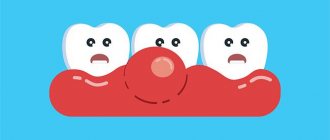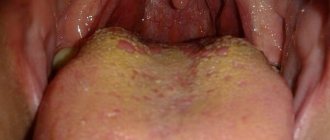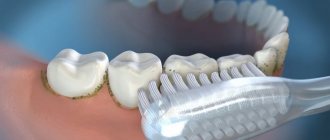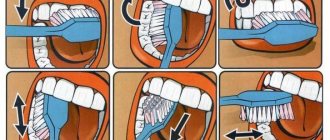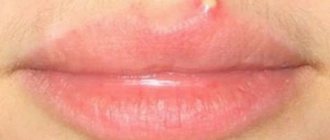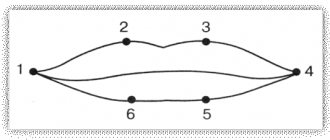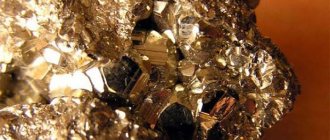Soft plaque that is not removed in time turns into stone over time.
Plaque forms constantly in the oral cavity, since the process of microflora reproduction does not stop (its intensity especially increases after eating). If soft deposits are not removed, they gradually become saturated with mineralized salts contained in saliva and harden (on average, mineralization occurs within 16 hours after eating, but this figure may vary slightly, both smaller and larger).
Why does tartar form?
The appearance of tartar can occur for a number of reasons:
- Poor oral hygiene. First of all, you need to choose the right toothbrush - it should have bristles of different lengths and shapes. It is equally important to use a toothpaste that can effectively cope with plaque – it must have an abrasiveness index of at least 50 RDA.
- Unbalanced diet. Foods high in carbohydrates – flour, pasta, carbonated sweet water, etc. – provoke stone formation.
- Drinking strong black tea and smoking regularly. The latter is especially dangerous, since heated smoke intensifies the inflammatory process in the gums.
- Violation of pH levels. When it decreases, the acidity of saliva increases, as a result of which more minerals and salts are deposited on the surface of the teeth. If the level, on the contrary, increases, the acidity of saliva decreases, which affects the enamel, which becomes more loose.
- High content of fluoride and calcium in saliva. The ions of these components accelerate the formation of tartar.
- Uneven bite. The distance between crowns is a good place for plaque to accumulate.
- Orthopedic fixed structures in the mouth (plaque accumulates in the gaps between dentures and stones form).
- Thyroid diseases and diabetes. These diseases are accompanied by disruption of endocrine processes, which leads to changes in the acidity of saliva.
- The absence of several teeth, which affects chewing. If a person has no teeth on one side, he spontaneously begins to chew on the other side of his mouth. As a result, teeth do not undergo the natural self-cleaning procedure, so plaque accumulates on them.
- Too increased or, conversely, decreased production of saliva due to disturbances in the functioning of the salivary glands.
- The use of medications that affect the composition of saliva.
Laser technique
Cleaning the tooth surface occurs without contact. The action of the device concerns exclusively dental plaque - neither the external nor the internal protective crown part of the tooth is affected. The principle of operation of the device is that it acts on liquid substances. The laser destroys tartar with its beam, and a stream of air and water entering the cavity washes out even the smallest particles of solid deposits.
This technique is distinguished by its effectiveness and safety, but it is not so popular due to its inflated price.
Is it painful to remove tartar ? No, modern treatment methods make it possible to carry out the procedure and make it absolutely painless.
Types of tartar
Tartar consists of one third of organic substances (epithelial cells, microorganisms, proteins, etc.) and 2/3 of inorganic substances (mainly calcium salts).
Stones are divided into:
- supragingival, which, as you can guess from their designation, are located above the gum. They are easy to see with the naked eye and are dark yellow in color. Removing such deposits is quite simple.
- subgingival. During a routine examination, they cannot be noticed, but their presence can be assumed by the bluish tint of the gums and increased bleeding in this place. It is possible that pus may be released from the periodontal pocket.
The presence of subgingival stones is the first sign of periodontitis and the beginning of tissue destruction around the tooth. Only a dentist can detect stones located under the gum by probing the pockets. Removing subgingival stones takes a lot of time, so not every doctor will undertake such work.
Types of Dental Raiders
They are divided only by location, so the following types are distinguished:
- Subgingival. They can be localized deep in the gums and are often found on the neck. This type of plaque is very difficult to notice. The risk group for this type of plaque includes people over forty. If you start treating subgingival plaque, you can be left without teeth, in the literal sense of the word.
- Supragingival. As the name suggests, this plaque is localized above the gum on the inner surface of the tooth, so it is very easy to notice. Most often white or yellow.
Supragingival calculus
- A stone bridge. This is when plaque is localized on several teeth in a row.
What does tartar look like?
Tartar: causes of appearance
Leftover food in the mouth after eating is a favorite treat for bacteria. Such microorganisms especially love the so-called “fast” carbohydrates, found in large quantities in flour products and sugar. It has been proven that even if oral hygiene is neglected one day, this will lead to accelerated plaque formation, increasing in volume several times over this period of time.
Bacteria need nutrients both to maintain vital processes and to produce enzymes that allow them to securely attach to the tooth surface. If you brush your teeth poorly, individual bacteria will begin to form colonies, which, in turn, can also merge with each other. Nevertheless, at this stage, eliminating plaque is not yet particularly difficult - you can get rid of it by working well with a toothbrush.
Over time, the plaque will mineralize (calcium salts and proteins present in saliva will begin to settle on the surface of the bacteria, which will proceed in parallel with the formation of new colonies), hardening and increasing in volume.
At the same time, toxins will be released from the plaque, causing the development of the inflammatory process. You can understand that inflammation has begun by pain in the gums, their bleeding during brushing, the flow of pus and increased tooth mobility.
The inflammatory process is of great importance for bacteria: the groove between the gum and tooth constantly receives liquid rich in proteins necessary for bacteria to grow; inflammation increases the formation of this fluid, accordingly, microorganisms receive more proteins, and the growth rate of their colonies becomes higher.
Concluding all of the above, the appearance of a stone is a direct consequence of non-compliance with hygiene.
How to remove tartar
If the plaque has formed into stone, then it will no longer be possible to get rid of it with an ordinary brush.
Tartar cleaning in Krasnodar is the only effective way to eliminate deposits. The professional method involves the use of ultrasonic cleaning: removing tartar from all teeth takes about one hour, if we are talking about supragingival deposits. To eliminate subgingival stone, you will have to visit the doctor several times, if his qualifications are sufficient to carry out the procedure.
It is better to immediately contact a periodontist rather than a therapist. This is especially true for people suffering from periodontitis, since they may have stones in the resulting pockets. If it is necessary to clean tartar located above the gum level, then a dentist-therapist will also help.
The cost of tartar removal in our clinic is 3,500 rubles. This includes polishing the teeth with a brush and toothpaste. Polishing teeth using a PROPHY flex device (a mixture of water, compressed air and fine sodium bicarbonate powder - baking soda).
Tartar - photo. Tartar - causes of formation. Stones on teeth: what causes them to appear. Supragingival and subgingival tartar – removal.
Table of contents
- What is tartar?
- Causes of tartar formation
- Forms of tartar
- What does the formation of tartar lead to?
- Prevention of tartar
- Preventative toothpastes
- Tartar removal
- How to remove tartar at home
- Description of clinic services and prices
What is tartar?
Tartar is a yellowish or brown layer of mineral hard deposits on the surface of teeth, formed by hardened plaque.
Normally, teeth are almost always present with dental plaque, which represents exfoliated epithelium and food debris. It's hard to notice. After each meal, new food remains, microbes and their metabolic products are added to it. With poor, irregular cleaning, soft and loose plaque, due to increased acidity, causes inflammation in the soft periodontal tissues - gingivitis. Gradually accumulating, with poor cleaning, the plaque hardens and turns into the colors of the products consumed. This causes people to dislike and want to whiten them. Tartar removal is important for oral hygiene because, in addition to being a cosmetic issue, it promotes further plaque accumulation and causes gum inflammation, gum recession and gum disease.
Causes of tartar formation
Anaerobic plaque bacteria produce acids as a byproduct of their metabolism. They create an acidic environment in the mouth, causing calcium to be lost from tooth enamel (demineralization). Calcium, phosphorus and other minerals from saliva are absorbed into plaque and harden. This hardened structure is tartar. Its main ingredient is calcium phosphate, a hard, insoluble material that adheres to tooth enamel.
Tartar roughens the surface of the teeth's crowns and roots, allowing even more bacteria and minerals to "stick" to existing tartar much more easily. The rough surface of tartar, combined with acids derived from bacteria and food debris, provides an ideal environment for further plaque accumulation and growth. Day after day, these repeated cycles of acid production, loss of calcium and calcium phosphates lead to the formation of new layers of tartar on the teeth. As the volume of tartar increases, the risk of space between the tooth wall and the gum increases, which contributes to the development of periodontitis.
The main proven cause of this phenomenon remains insufficient oral hygiene. Regular removal of soft and hardened plaque once every six months will ensure proper prevention of the development of periodontal problems.
Forms of tartar
- Supragingival calculus Supragingival calculus is the most common and less harmful type of plaque as it is easily detectable. But, increasing in volume, it “grows” under the gum, moving it away from the wall of the tooth. Such a movement is very dangerous, because can lead to disruption of the integrity of the ligaments that hold the tooth in the bone socket.
- Subgingival calculus on teeth The formation of calculus occurs below the level of the gums and is more dangerous, since food debris rushes into the formed pocket between the tooth and the gum, which is difficult to clean out from under the gums at home with the usual brushes and dental floss.
What does the formation of tartar lead to?
- Bacteria attach more easily to tooth enamel containing plaque or tartar than to the smooth surface of a tooth. When tartar forms below the gum line, it can lead to serious complications such as gum irritation and damage. At this point, the patient may experience bleeding gums, bad breath and pain when eating. If you do not pay attention to such manifestations of gingivitis and periodontitis, this can lead to the progression of the disease and an increase in symptoms. The roots of the teeth are exposed and the stability of the tooth is lost due to a violation of the attachment of the tooth in the bone socket.
- Removing plaque by brushing and flossing becomes increasingly difficult. Brushing and flossing become virtually impossible when tartar builds up on your teeth. Additionally, acids released by bacteria in the mouth affect tooth enamel, causing tooth decay, tooth loss, or jaw bone degradation.
- Tartar irritates the gum tissue and causes gum recession. Subgingival anaerobic bacteria, which survive without oxygen, are responsible for the development of periodontitis by causing damage to the gums and gingival fiber - which forms the connection between the gum and teeth
- The risk of developing caries and gum inflammation increases.
- Teeth appear unattractive due to stains caused by tartar. In addition to cosmetic problems associated with tartar buildup, such as brown or yellowish teeth, other dental diseases can occur. Against the background of gingivitis and periodontitis, it is difficult to heal postoperative wounds in the oral cavity, it is impossible to carry out orthodontic treatment, and there is a high risk of relapse of caries after its treatment in a “dirty” oral cavity.
Poor oral hygiene and infertility in men
A study has found a link between low sperm count, a cause of infertility in men, and poor oral hygiene. The study found that bacteria responsible for gum disease may also reside in the spermatic cord and affect sperm quality.
Prevention of tartar
- Proper and regular brushing and flossing are essential to reduce plaque and plaque buildup.
- Professional hygienic teeth cleaning by a dental hygienist should be carried out on a regular basis at least once every 6 months
- The use of toothpastes that prevent the formation of tartar, as well as other additional hygiene products, such as a tongue scraper, solutions and foams for irrigating the oral cavity after meals, monotuft brushes, brushes for cleaning interdental spaces, etc.
Remember that it is recommended to brush your teeth after every meal. Using dental floss helps clean the interdental spaces (often toothbrush hairs cannot get there). Chewing gum is also recommended for use, especially without a brush or floss.
Preventative toothpastes to slow down the formation of tartar
They are a special type of toothpaste that can help reduce the formation of new tartar, but they cannot remove existing tartar. They work by reducing the concentration of calcium phosphate in the mouth and absorbing it from plaque, preventing the formation of tartar.
Using them in some cases may cause increased sensitivity to hot and/or cold water/food in some teeth or irritation of the soft tissues of the oral cavity.
Tartar removal
Tartar is too hard on the surface of the teeth. It cannot be removed by regular brushing or flossing (regular plaque removal procedures). Only professional teeth cleaning by a dentist can remove it. Dentists use special instruments:
- Ultrasonic scalers are small thin instruments through which ultrasonic waves are applied to the surface of the tooth and break up hard plaque.
- Curettes and hand scalers are hand-held instruments for removing tartar above and below the gum and smoothing the root surface.
The removal of supragingival and subgingival stone is carried out. In the first case, the procedure does not take more than an hour to remove stone from all teeth. In the second case, a higher qualification of the doctor (periodontologist) is required - because In patients with periodontitis, stone deposition occurs in periodontal pockets.
After ultrasonic cleaning, it is recommended to grind the teeth with a special air-abrasive-water mixture AirFlow.
How to remove tartar at home
Plaque begins to form within 4-12 hours after brushing, so it is important to brush your teeth at least twice a day. Brushing and flossing regularly can help reduce plaque and tartar. Using the following home remedies can help prevent complications from tartar, including tooth decay, gum disease, and bad breath.
- Toothbrushes
- Classic electric brush
- Sonic toothbrushes
- Ultrasonic electric toothbrushes
Description of clinic services and prices
In our clinic you can carry out a full range of all hygienic procedures:
- Ultrasound removal of tartar – 150 rubles
- removal of dark plaque – 150 rubles
- removal of subgingival tartar – 170 rub.
- removal of dental plaque from an implant – 700 rubles.
- complex price for removing plaque and polishing with soda powder – 3,450 rubles.
- complex price for removing plaque and polishing with calcium – 4000 rubles.
{jlcommentspro}
Tartar: how to get rid of it at home
Most people understand that the best way to resolve any dental problems is to visit the dentist. However, not everyone likes to contact a specialist, delaying the visit until the last minute in the hope that the problem will somehow resolve itself. This is largely facilitated by advertising offering treatment for all occasions.
So how to remove tartar at home? Unfortunately, no way. Even the most expensive products will not be able to remove thick plaque and stone. However, ultrasonic or electric brushes, as well as special toothpastes, will help get rid of the soft plaque that is just beginning to form.
Complications of unremoved dental “fossils”
If you do not visit the dentist regularly, you may experience complications such as:
- inflammation of the gums;
- bleeding gums;
- caries. Plaque contains microorganisms that lead to caries;
- stains on enamel. Most often they are localized at the point of transition from the gum to the root;
- gum atrophy.
The presence of such stones indicates the development of periodontitis, and is associated with the destruction of the attachment of the gum to the tooth, as well as the destruction of bone tissue around the tooth
Consequences of stones
If the stones are not removed, this can lead to:
- the appearance of bad breath (its cause is the vital activity of microorganisms that have settled on the surface of the teeth);
- the formation of caries (bacteria in the process of life produce hydrochloric acid, which corrodes the enamel, which contributes to the onset of decay);
- inflammation of the gums, their bleeding, which can subsequently result in periodontitis;
- diseases of the mucous membrane (accumulation of colonies of microbes on the teeth can lead to ulcers and erosions);
- worsening of existing diseases (diabetes, heart disease, etc.).
It's all due to poor hygiene
Hard plaque is a special mineralized film that consists of many microbes. Poor daily brushing leads to their proliferation and promotes the growth of a soft, invisible film on the teeth. It, under the influence of microflora, begins to actively mineralize within fifteen hours.
Mineralization is completed after 7 days, and after 6 months full-fledged stones appear on the bone formations. The outer protective shell of the coronal part of the tooth, which is overgrown with plaque, begins to darken, but this is not the only negative aspect: hardened plaque (dental deposits) is the main infectious center and becomes the basis for the appearance of a number of diseases, which cause many troubles, including tooth loss.
Thus, cleaning hardened plaque is not only a hygienic aspect. This procedure can be called tooth-preserving, and competent treatment at the dentist is rarely complete without it. Before: replacing a lost or irreversibly damaged tooth with an artificial implant; installation of orthodontic braces; whitening or other procedures, the specialist carefully removes the stones so that the procedure leads to a positive result.
Tartar
How to remove tartar
There are the following methods for removing tartar:
- manual;
- using ultrasound;
- using laser;
- sandblasting;
- chemical method.
Each of these methods has its pros and cons.
The mechanical or manual method is the oldest method of removing tartar in Krasnodar, so it is used extremely rarely. Cleaning is carried out either manually (the doctor uses special tools to remove stones) or using a drill with special attachments. Its advantages include low cost and versatility, but its disadvantages are that it is traumatic for the gums and a long recovery period.
Ultrasound is a more modern and effective method. Special devices called scalers are used for it: they can emit ultrasonic vibrations with a frequency of up to 50 kHz. The impact of scalers can be mechanical (vibrations are transmitted to the attachments that act on the teeth) or by the cavitation method (during operation, an antiseptic solution is supplied, in which bubbles are formed under the influence of ultrasonic waves, exploding at the moment of contact with the surface of the teeth, which leads to the destruction of stones) . Unlike the previous method, scalers do not injure teeth and gums, and their use is completely painless for the patient. However, there are contraindications: for example, the presence of braces prohibits the use of the method.
Cleaning tartar using sandblasting involves removing deposits with a mixture of water, air and abrasive. The method is characterized by the absence of trauma, after its use the teeth can become several shades lighter, and the presence of braces is not an obstacle. However, sandblasting cannot get rid of large deposits, and during the procedure, the taste of soda is clearly felt in the mouth, which can be unpleasant for the patient.
Laser cleaning is an innovative method that is less traumatic. The teeth are treated with a laser beam, which evaporates the liquid from the deposits, resulting in their destruction. There is no damage to the enamel. The method is quite expensive: perhaps that is why it is not very widespread. In addition, there are many contraindications for its use.
A chemical method is used to soften particularly large deposits. A special product is applied to the stone, which makes it loose, after which the deposit is removed using any of the above methods. In order not to damage the gums, before the start of the event they are treated with a rubber dam - a product that protects against burns. Among the advantages, it is worth highlighting the possibility of removing old deposits and safety for fillings. The disadvantages are the impossibility of using it as the only method, the impossibility of removing subgingival deposits with its help, and the prohibition of use for gingivitis.
It is worth understanding that it will not be possible to get rid of tartar at home: even the most modern and expensive toothpaste from tartar can only remove soft plaque that has a loose structure, but if the hardening process of the deposits has already completed, you can only get rid of them in the hospital.
Preventive measures
The best method of prevention is careful hygiene. Basic rules that should be followed to prevent the formation of stones and other problems with teeth are as follows:
- Teeth must be brushed after every meal;
- Before using the paste, you should use dental floss, since the brush cannot penetrate into all the spaces between the teeth;
- If you can't floss outside the home, you can chew chewing gum.
Why does it appear?
The main cause of any problem is insufficient hygiene. If you regularly cleaned your mouth poorly, did it with the wrong brush, or used a low-quality paste, then expect the formation of not only hardened plaque, but also destruction of hard tooth tissue, and other equally dangerous diseases. To avoid adverse effects, choose the right brush and toothpaste, also follow the correct technique for brushing your teeth and be sure to rinse and floss your mouth after eating.
The accelerated appearance of hardened plaque causes:
- Hobbies for confectionery, carbonated drinks, foods rich in simple carbohydrates;
- Frequent consumption of soft or liquid foods, food fillers and flavored sweeteners;
- Poor diet;
- Drinking alcoholic beverages and smoking;
- Heavy secretion of saliva;
- Taking a number of pharmacological drugs;
- Chronic inflammatory diseases.
